Light intensity and hydrogel soil amendment differentially affect growth and photosynthesis of successional tree species
Léo Vieira Leonel·Fabrício de Oliveira Reis·Fábio Afonso Mazzei Moura de Assis Figueiredo·Tiago Massi Ferraz·Sebastião de Oliveira Maia Júnior·Patrick Costa Silva·Jailma Ribeiro de Andrade
Abstract Global climate changes have increased temperatures,radiation indexes,and consequently,irregularities in rainfall in mainly tropical countries,considerably hindering plant establishment in recovering degraded areas.The objective of this study was to evaluate the growth and physiological characteristics of one species of each successional group:pioneer,secondary,and climax when subjected to different light intensities and hydrogel as a soil conditioner during rainy and dry periods.The experiment was conducted in the ecotone between Brazil’s two largest biomes,the Cerrado and the Amazon in the State of Maranhão.The parameters consisted of three species:Guazuma ulmifolia Lam.(pioneer),Astronium fraxinifolium Schott (secondary),and Cariniana rubra Gardner ex Miers (climax).There were two light intensities:70% and 100%,and two planting conditions:with and without soil conditioner (hydrogel).Gas exchanges were higher during the rainy season;the pioneer and secondary species had greater heights and photosynthetic rates in the dry period;the climax species had the lowest gas exchange and lowest recovery as rainfall resumed.The pioneer and secondary species showed higher physiological plasticity,denoting better adaption to environments with high irradiance.Hydrogel improved the photosynthetic performance of these species in the dry season and in areas with 100% sunlight.
Keywords Irradiance·Hydrogel·Photosynthetic efficiency·Physiological plasticity
Introduction
Global climate changes have contributed to increased atmospheric CO2and soil temperatures,causing serious losses to ecosystems,particularly those in tropical climates (Mendes et al.2017 ;Santos et al.2019).Increases in world population have also negatively affected ecosystems,suppressing or removing natural vegetation due to construction,road building,and new agricultural areas (Farias and Zamberlan 2013).
The Cerrado and Amazon biomes in Brazil have a high diversity of native forest species that have been negatively impacted by the advance of the agricultural frontier,aggravating socioenvironmental problems (Souza et al.2010;Weihs and Sayago 2015),such as the deforesting of areas causing loss of natural environments (Hentz et al.2013).In addition,hot,dry climates in some tropical areas significantly affect the development of secondary and climax species,to the benef it of pioneers,increasing the proportion of degraded areas and hindering their recovery (Anjos et al.2015;Santos et al.2019).
Pioneer species are fast-growing and show tolerance to high luminosities,and good adaption to degraded,low fertile soils (Acabora et al.2011).These species increase soil protection and quality,resulting in microclimates for the establishment of subsequent successional stages (Pereira and Rodrigues 2012).Early and late successional species have faster growth during rainy seasons than during the dry seasons when they may undergo significant physiological damage (Santos et al.2019).
In dry seasons,species from different successional groups show different responses to stresses such as high luminosity and water def icits (Santos et al.2019).This is crucial for the adaption and survival of species in stressful environments,extreme radiation,and temperatures affect the photosynthetic machinery of plants,with significant decreases in light absorption and energy use (Anjos et al.2015).This can be measured by physiological characteristics such as the SPAD chlorophyll and photosynthetic indexes,and gas exchanges (Endres et al.2010;Mendes et al.2017;Santos et al.2019;Zhang et al.2019).
Studies have shown that the SPAD chlorophyll index and stomatal conductance of seedlings of a pioneer species (Tabebuia chrysotricha(Mart.ex A.DC.) Standl.) increased in shaded environments above 70%,but photosynthesis decreased at 95% shading (Endres et al.2010).In addition,Santos et al.(2019) found that a pioneer species (Schinus terebinthifoliaG.Raddi) under seasonal luminosity fluctuations performed better than a late successional species (Eugenia uniflora),since the photosystems of late seral species are under low luminosity which is aggravated in low rainfall seasons.Therefore,hydrogel,a hydrophilic polymer that is highly absorbent,has been used as a soil conditioner to reduce seasonal water def icits and irradiance effects on different forest species and has enabled plants to survive in dry seasons (Jamnická et al.2013;Tomášková et al.2020;Nascimento et al.2021;Santos et al.2021).Hydrogel was benef icial for the maintenance of photosynthesis and water use efficiency inFagus sylvaticaL.seedlings over 50 days of dehydration (Jamnická et al.2013),and improved the maximum photosystem II efficiency and the growth ofCampomanesia xanthocarpa(Mart.) O.Berg.seedlings grown in pots with 50% water availability (Santos et al.2021).
Studies have shown that pioneer species are more plastic than late successional species (Pereira and Rodrigues 2012;Santos et al.2019).However,new evidence has shown that the capacity to modulate the photosynthetic apparatus is connected to specificities of each species and not necessarily to the successional group (Gaburro et al.2015;Nina Junior et al.2020).Therefore,considering the large number of successional species in tropical forests,information on their physiological and morphological responses and their use in the species screening process before planting can increase the probability of success in reforestation (Lestari and Nichols 2017),particularly when the species occur in transitional biomes such as the Cerrado-Amazon ecotone.
It was hypothesized that the pioneer speciesGuazuma ulmifoliawould be more tolerant to high luminosity and dry conditions than other species,besides being favored using hydrogel in the dry period.In this context,the objective of this study was to evaluate the growth and physiological characteristics of one species of each successional group,pioneer,secondary and climax,during rainy and dry periods,(1) under different light intensities;(2) soil conditioner with hydrogel;and,(3) light intensityxhydrogel.
Material and methods
Study area and environmental conditions
The experiment was conducted in an ecotone between the two largest biomes,Cerrado and Amazon,in the State of Maranhão,northeast Brazil (5°28'42.56" S,47°27'22.19" W,and elevation of 92 m.a.s.l).The region has an Aw climate (hot and humid with rainy season in summer and dry in winter) according to the Köppen classification (Köppen 1948),with total annual rainfall of 1221 mm distributed in a five-month rainy season (December to April).Mean daily temperatures are approximately 26.7 °C in rainy months and 30 °C in dry months.Mean relative humidity during the day is 53.0% in the dry season and 80.5% in the rainy season (Fig.1).
Experimental design and treatments
A randomized block design in a 3 × 2 × 2 factorial arrangement with five replications was used.The variables were three forest species:G.ulmifolia,Astronium fraxinifolium,andCariniana rubra;two light intensities:70% and 100% luminosity;and two soil conditions,with and without hydrogel (Fig.1).
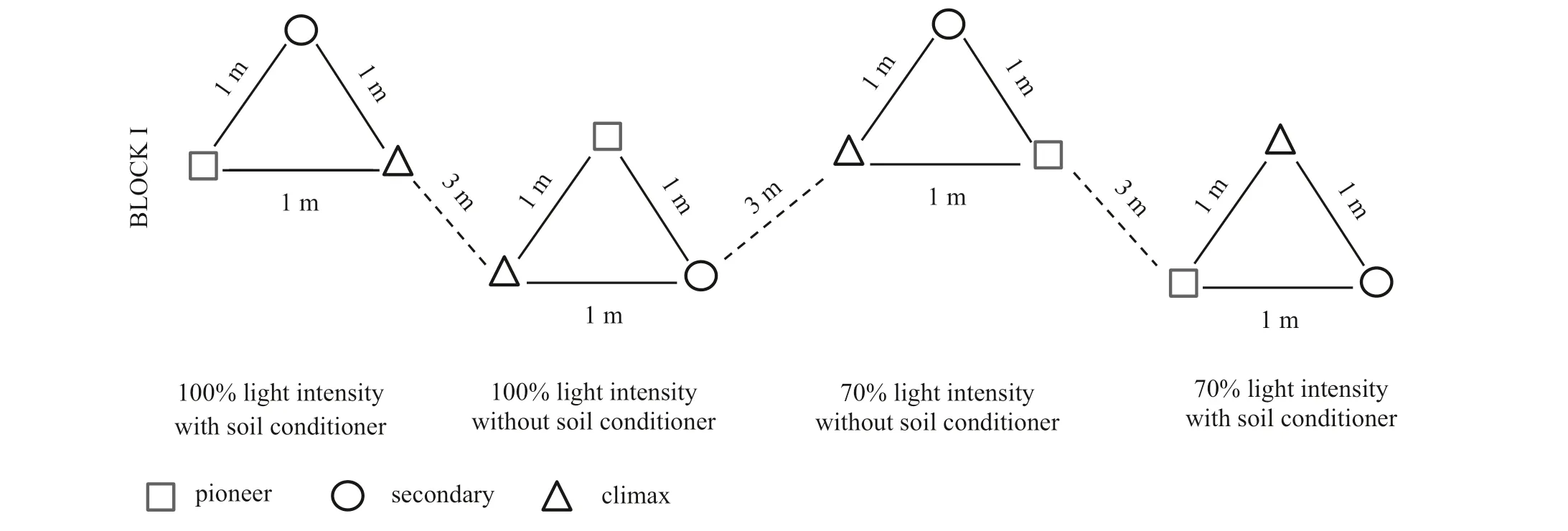
Fig.1 Spatial distribution of treatments per block
The experiment was composed of 32 nuclei (Anderson 1953),each consisting of three species,totaling 96 seedlings.Regarding the ecological succession,the species were classif ied as pioneer species (G.ulmifolia) (Ribeiro et al.2005);secondary species (A.fraxinifolium) (Santos et al.2004);and climax species (C.rubra) (Carrero et al.2014).
The seedlings were local native species donated by the Consórcio Estreito Energia (CESTE;Estreito,MA,Brazil),grown in 175 cm3plastic tubes placed in 54-cell trays in a nursery with 50% light interception.The substrate used for seedling production consisted of poultry litter (10 kg),sand (50 kg),N -P -K (4 -14 -8 at 2.5 kg),soil (110 kg),commercial substrate (Bioplant) (32 kg),and rock phosphate (3 kg).The seedlings were produced in the nursery between August 2015 and February 2016,irrigated by an automatic micro sprinkler system,maintaining the substrate always close to the substrate water capacity until transplanting February 08,2016.However,between February 02 and 08,the seedlings were acclimatized,gradually lowering the water supply and making them more adapted to field conditions.
A structure 3.5 m height,25.0 m length,and 12.0 m width (300 m2) was built for the shade treatment,with a shade screen with 30% light interception.
The characteristics of the hydrogel (Hydroplan-EB/HyB) are shown in Table 1.A1-L the hydrated product was mixed into the soil when the seedlings were transplanted.
The experiment was carried out in a deforested area which had undergone vegetation suppression and ground leveling (Table 2).Planting holes were marked with a 1-m equilateral triangle at 25 cm width and 40 cm depth.
Four biometric and physiological measurements were carried out between 07:00 and 9:00 a.m.on March 01 (rainy season),June 20 (last rainy season),September 18 (dry season),and October 02,2016 (last dry season).
Plant growth
Growth characteristics measured were height,considering,distance between the root collar to the highest leaf (cm),and stem diameter above the soil.
Gas exchange
Gas exchange was measured in the middle third of fully expanded leaves using a LI-6400XT portable photosynthesis System (LI-COR Biosciences,Lincoln,NE,USA).The photosynthetic CO2assimilation (A),stomatal conductance (gs),transpiration (E),and leaf-air vapor pressure def icit (VPD) were measured under photosynthetic photon flux density 1500 μmol m-2s-1,air flow 500 μmol inside the chamber,and CO2concentration adjusted to 400 ± 20 ppm.
PSII efficiency
Chlorophyll fluorescence was measured using the same leaves used for gas exchange evaluations.They were preadapted to the dark for 30 min using specif ci clips (Maxwell and Johnson 2000).Measurements were carried out using a non-modulated portable fluorimeter (Pocket-PEA;Hansatech,Norfolk,UK),which provides data of maximum quantum efficiency of photosystem II (Fv/Fm) and photosynthetic index (PI).
SPAD chlorophyll index
This was measured using a portable chlorophyll meter (SPAD-502 Plus,Konica,Japan),the data were collected from fully expanded leaves with readings in five different points and expressed as the mean per leaf.
Statistical analysis
Data of each time were subjected to ANOVA to analyze the effect of the different treatments on the variables.Species data were compared by Tukey’s test (P< 0.05) and the other means by the t test (P< 0.05).All analyses were carried out using the Assistat 7.7 program.
Results
Dynamic changes of climatic factors
Rainfall amounts ranged from 0.4 mm to 190.8 mm,air temperatures from 26.7 °C to 30.1 °C,and relative air humidity from 53% to 84.2% during the study.Mean photosynthetically active radiation ranged from 596.8 to 1467.9 μmol·m-2·s-1(Fig.2 a-c).
Growth
Height of the climax species in the rainy season was 17.7% and 30.8% higher than those of the secondary and pioneer species,respectively,but was similar between light intensity and with and without hydrogel (Table 3).Similar results were found in the last rainy season between light intensity and hydrogel,however,the pioneer and secondary species stood out over the climax species.In the third measurement,the dry season,100% light intensity resulted in the highest heights,36.2% higher than 70.0% light intensity;the pioneer and secondary species were 160.8% and 134.0% higher than the climax species,respectively.In the last dry season,heights in 100% light intensity were 36.0% higher than under 70% light intensity;the pioneer and secondary species were 161.9% and 127.6% higher than the climax species,respectively.Hydrogel had no effect on plant heights (Table 3).
Stem diameters in the rainy season varied between species and were higher in the climax species,29.5% and 32.5% higher than those of the pioneer and secondary species,respectively (Table 3).In the second last rainy season,diameters were higher for the pioneer species,88.9% higher than the other seral communities.Plants without hydrogel had 12.0% higher diameters than those with hydrogel.In the dry season,plants under 100% light intensity had 32.5% higher diameters than those in 70% light intensity,and the pioneer species had 93.9% higher diameters than the secondary species,and 205.7% higher than the climax species (Fig.2).Similarly,in the last dry season,plants in 100% light intensity had 37.5% greater diameters than those in 70%;the pioneer species had 90.9% and 198.3% higher diameters than the secondary and climax species,respectively,without effect of hydrogel (Table 3).
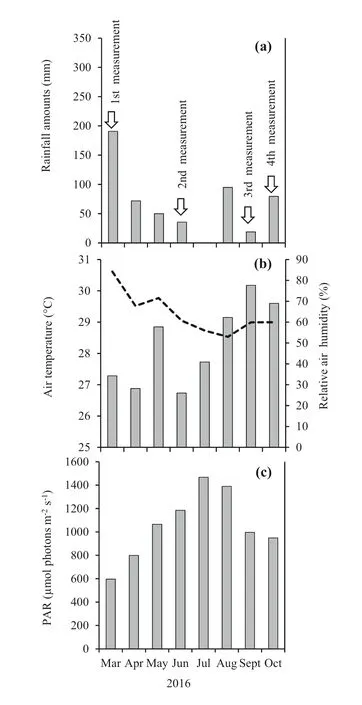
Fig.2 Climate characteristics:a rainfall amounts; b air temperature and relative humidity; c photosynthetically active radiation (PAR) from March to October 2016
Gas exchange

Stomatal conductance (gs) of the pioneer species was 116.6% higher under 100% light intensity and 92.8% higher under 70% than those of the other successional species in the rainy season (Table 4;Fig.3 a).In the last rainy season,plants under 70% light intensity without hydrogel had 60% highergsthan those with hydrogel (Fig.3 b).In the dry season,the climax species had lowergsin both treated and untreated soils;the pioneer species had 175% highergsthan the other species in the presence of hydrogel (Fig.3 c).In the last dry season,there were no differences forgsin any of the treatments (Table 4).
Transpiration (E) in the rainy season was different between species (Table 4);it was 37% and 71.6% higher forpioneer species when compared to the climax and secondary species,respectively (Table 5).In the last rainy season,Ewas similar between plants in 100% light intensity,but 78.8% higher under 70% without hydrogel,when compared to soil with hydrogel (Fig.3 d).In the dry season,Ewas lower in the climax species,regardless of with or without hydrogel,but the pioneer and secondary species transpired more when using of hydrogel (Fig.3 e).In addition,VPD was higher in the climax species in both soil conditions,with 19.5% higher VPD than in the others (Fig.3 f),and the pioneer species had lower VPD when using hydrogel.

Table 2 Physical and chemical characteristics of the soil of the experimental area
Photosynthetic CO2assimilation (A) was different within the factors in the rainy season (Table 4),with higherAin plants in 100% light intensity when compared to 70% light intensity,and in the pioneer and climax species when compared to the secondary species (Table 5).Plants in soil with hydrogel had lowerAthan those in soil without hydrogel.In the last rainy season,Awas higher to pioneer species (Table 5).However,CO2assimilation of plants in 70% luminosity was 75.7% higher without the use of hydrogel (Fig.3 g).In the two latest measurements (dry seasons),the climax species had lower CO2assimilation regardless of light intensity and the use of hydrogel.The pioneer species had higherA,mainly when using hydrogel (Fig.3 h-i) and the highest increase was in the last rainy season,which was 91.1% and 482.1% higher than that for the secondary and climax species,respectively.
All gas exchange parameters showed more response to rainfall amount than to air temperature,except for VPD which was significant for both climate parameters.E,gs,andAwere generally higher in the rainy season,with the highest values for the pioneer species,and the lowest for the climax species,which showed lower recovery when rainfall was resumed (Fig.4 a-f).Vapor pressure def icit stayed higher under low rainfall and temperatures were high,mainly for the climax species (Fig.4 g-h).
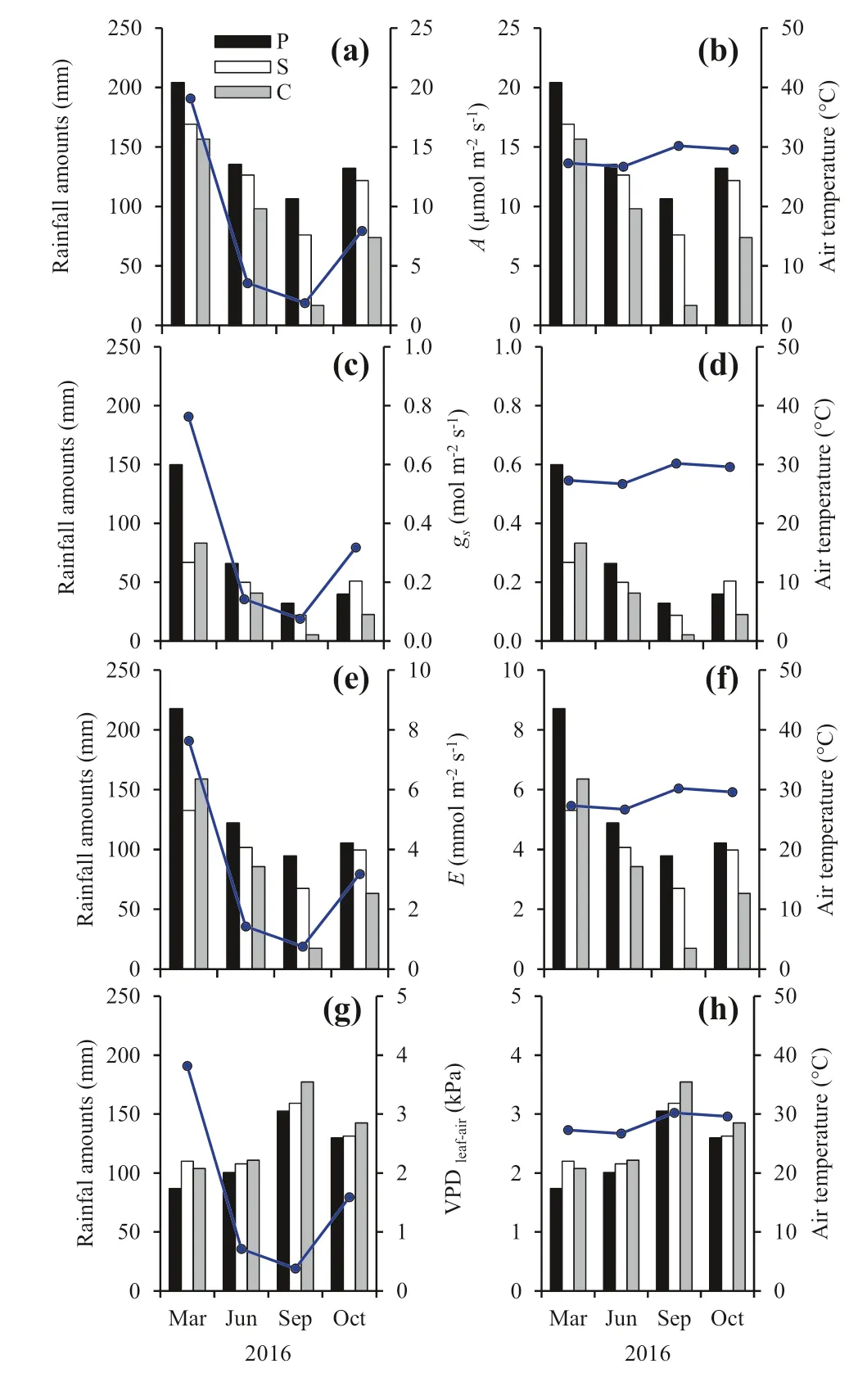
Fig.4 Photosynthetic CO2 assimilation (A),stomatal conductance (gs),transpiration (E),and leaf-air vapor pressure def icit (VPD);rainfall amounts and air temperature (rows) in field conditions for three forest species with seasonal rainfall.P=pioneer;S=secondary;C=climax
PSII efficiency
The maximum quantum efficiency of photosystem II (Fv/Fm) was different in treatments species and hydrogel in the lasttwo measurements,respectively (Table 4).In the dry season,theFv/Fmwas 8% lower in plants without hydrogel when compared to those with hydrogel in full sun and similar between soil conditions in the shaded environment (Fig.5 a).In the last measurement (last dry season),theFv/Fmwas different between species and between soil conditions.It was lower in the climax species (0.76) and in soil without hydrogel (0.79) (Table 5).
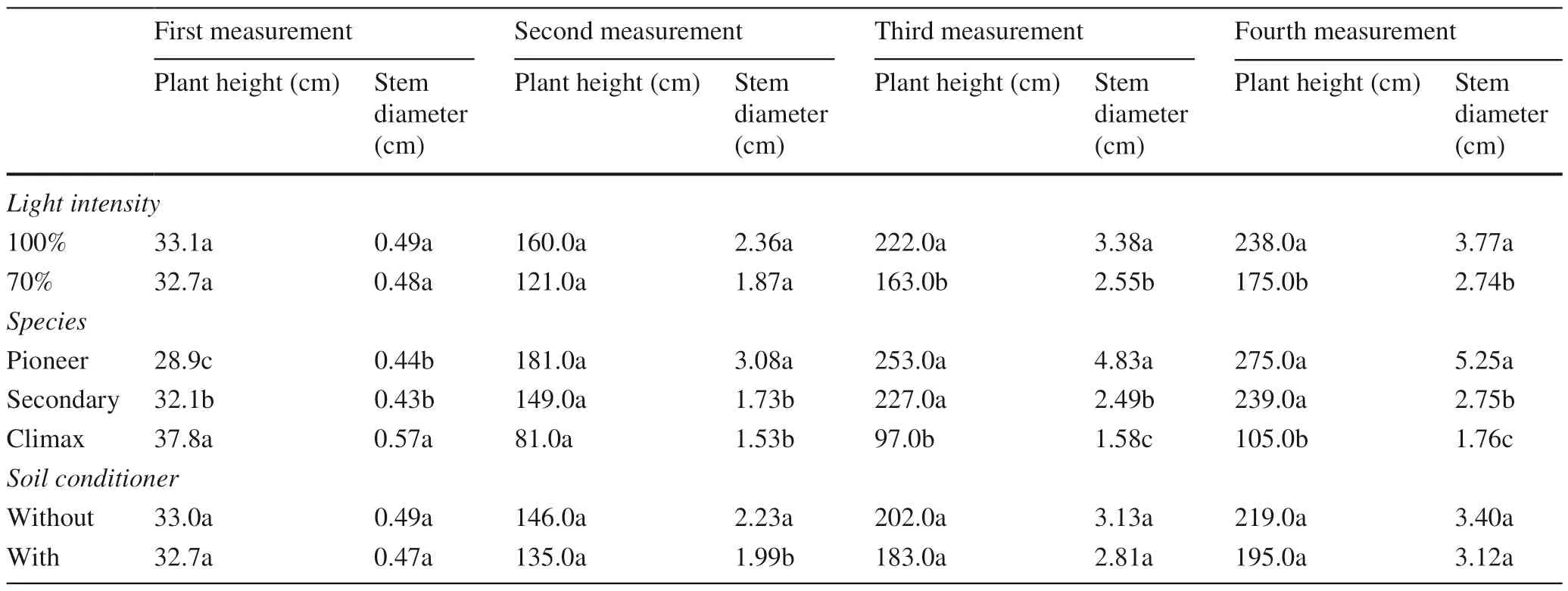
Table 3 Means of growth parameters of three forest species under different light intensities and with/without hydrogel
Photosynthetic indexes (PI) in the two frist measurements were different amongst species (Table 4).Secondary and climax species had higher PI in both measurements (Table 5).In the dry season,plants in the full sun had 92.5% higher PI with hydrogel compared to plants without hydrogel.The PI in the 70% and 100% luminosity were similar without hydrogel (Fig.5 b).In the last dry season,the climax species in full sun had 354.6% and 479.1% lower PI than the secondary and pioneer species,respectively,without hydrogel,and 216.6% and 73.1% lower PI when using hydrogel,respectively (Fig.5 c).Similarly,in 70% light intensity,climax species had 115.5% and 25.3% lower PI than secondary and pioneer species without the use of hydrogel,and 134.2% and 102.1% lower PI when using hydrogel,respectively.
Soil plant analysis development (SPAD) chlorophyll index
The SPAD chlorophyll index in the rainy season was higher for secondary species in 100% and 70% luminosity and similar with that of the climax species in the 70% luminosity environment,which were 25% higher than the pioneer species (Fig.5 d).In the last rainy season,the SPAD index were different among species;climax species had 35.9% and 27.9% higher SPAD than the pioneer and secondary species,respectively (Table 5).In the dry season,100% luminosity resulted in 8.1% higher SPAD index than in the 70% luminosity (Table 5).In the last dry season,the SPAD indexes were similar under the full sun (100% luminosity) but under 70%,it was 15.9% higher without hydrogel when compared to the treatment with hydrogel (Fig.5 e).
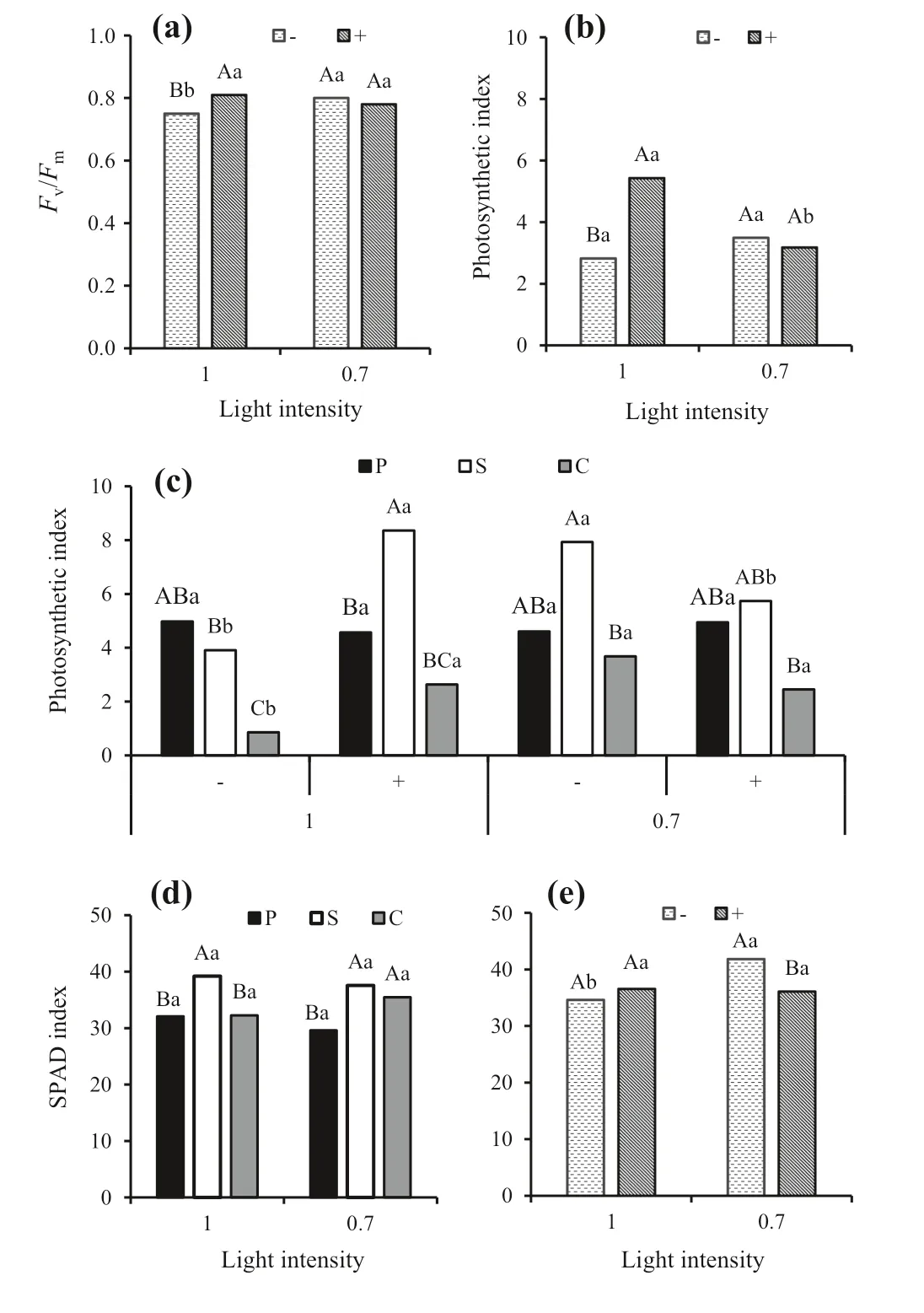
Fig.5 Maximum photochemical efficiency of PSII (Fv/Fm),photosynthetic index (PI),and SPAD chlorophyll index of species in different environments and with/without hydrogel; d =f irst measurement; a and b =third measurement; c and e =fourth measurement;P=pioneer;S=secondary;C=climax;-and+=without and with hydrogel,respectively.Bars with the same uppercase letter and different fillings,or with the same lowercase letter and equal fillings are not significantly different from each other
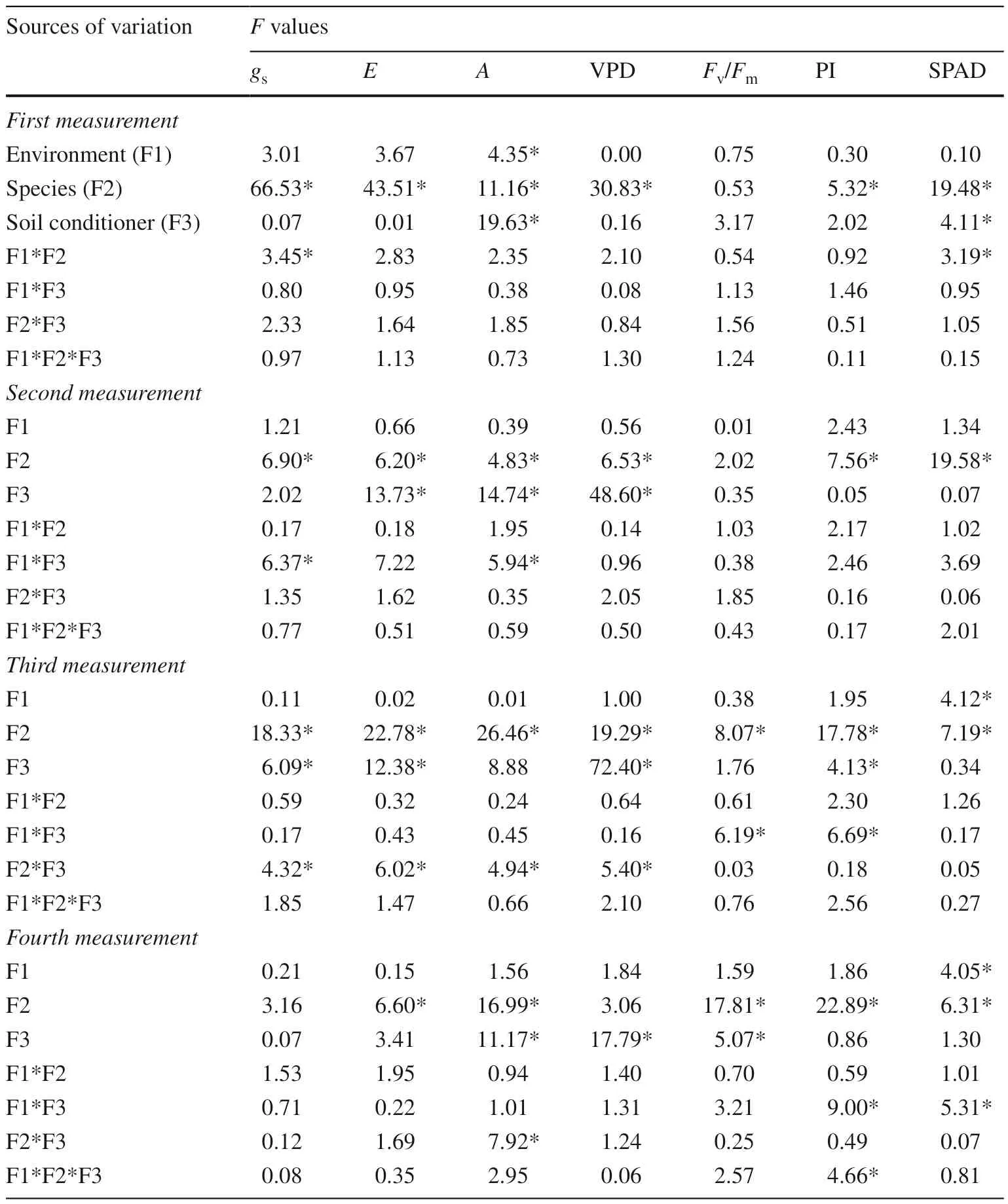
Table 4 Analysis of variance of ecophysiological parameters of three successional species in different light intensities and with/without hydrogel
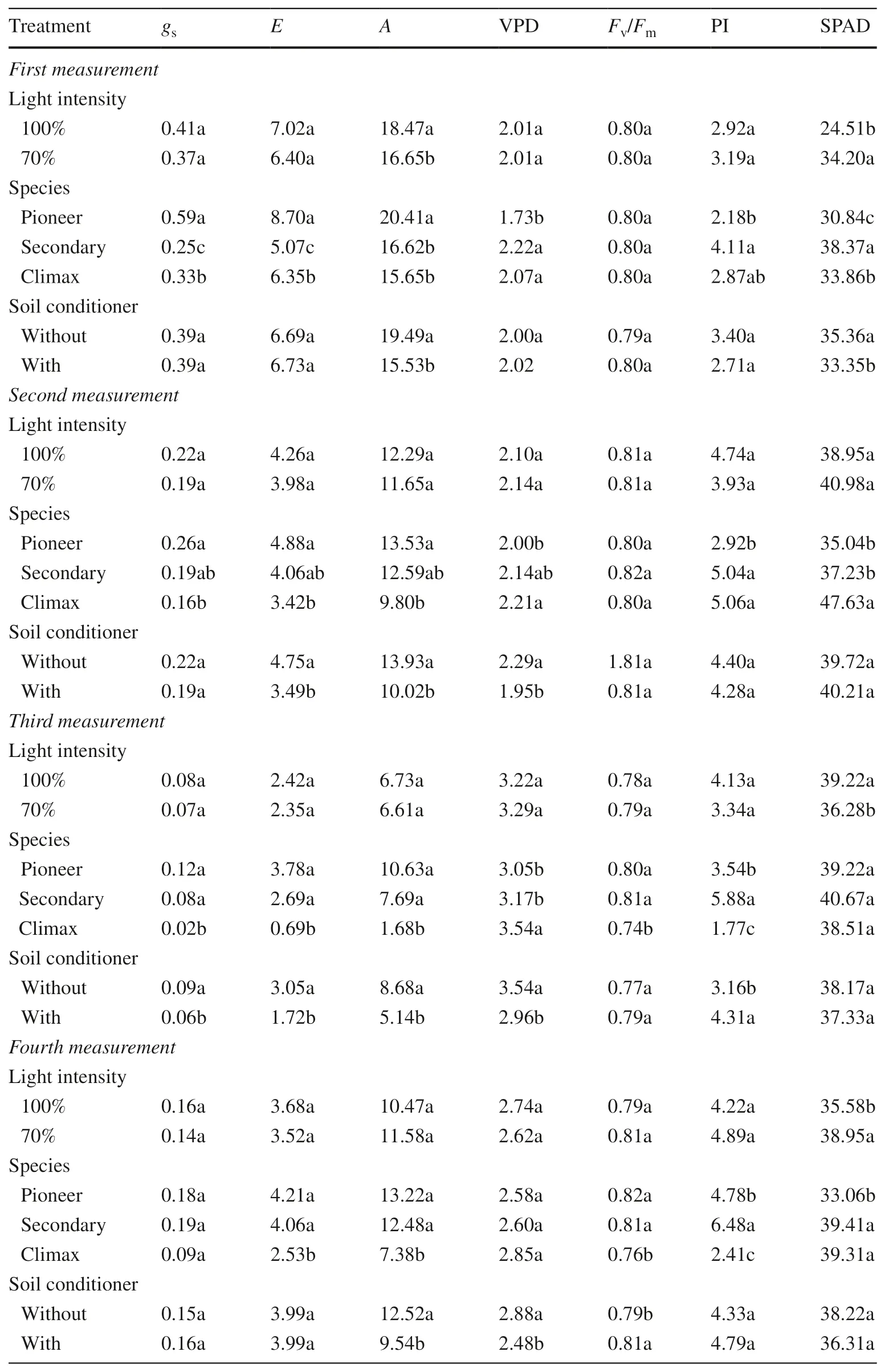
Table 5 Mean values of ecophysiological parameters of three forest species in different light intensities and with/without hydrogel
Discussion
The results show that the representative species of the pioneer group (G.ulmifolia) had the highest growth in height and diameter except the initial stages of growth,regardless of other treatments.Melotto et al.(2009) and Santos et al.(2019) conf rim the importance of this species for areas under restoration in full sunlight.However,its growth and survival are affected by soil water availability (Scalon et al.2011).Therefore,soil conditioning with hydrogel has been widely used to decrease the effects of water stress on plants (Tomášková et al.2020;Nascimento et al.2 021).
The secondary species (A.fraxinifolium) had greater height in 100% light intensity (full sunlight),as the species adapts well to hot environments which is important for reforestation projects.This is consistent with information that this species is well-adapted to environments with water scarcity (Campelo et al.2015).The climax species (C.rubra) had better development in 70% light intensity,resulting in better edaphoclimatic conditions to its development;thus,young plants of this species have better development in shaded environments under the canopy of pioneer species.This was also reported by Santos et al.(2019) who found higher plant heights for pioneer species when compared to late successional species.
Considering that climax species develop better under shaded areas,the Anderson nucleation technique which consists of planting seedlings of different species grouped together is benef icial for application in projects for degraded areas since it enables the interspecific interaction of species in the same place (Reis and Kageyama 2003).Therefore,fast-growing species (pioneers) create a micro-habitat of shade to secondary and climax species,an important factor for their growth and development (Leonel et al.2016).
The high growth of the pioneer species may be attributed to higher stomatal conductance during initial growth stages regardless of the environment.High rainfall e favored gas exchange of this species,however thegsdid not follow theAtrend,as also found by Santos et al.(2019).Thus,this high stomatal conductance without changes inAis possibly due to photoinhibition because of the little time after planting in the field when the seedlings had not fully established physiological mechanisms.In the third measurement (dry season),the climax species had lowergs,E,andAassociated with higher VPD.A strong correlation betweengsand VPD was found,mainly in drier seasons (Santos et al.2014).In addition,pioneer species had better photochemical performance under high irradiance than non-pioneer species (Nina Junior et al.2020).Stomatal conductance is a parameter directlyaffected by climate conditions that stimulate the opening or closing of stomata,and stomata closure decreases photosynthesis,transpiration (Tezara et al.2002;Marenco et al.2014) and,consequently,the photoassimilate production of plants.
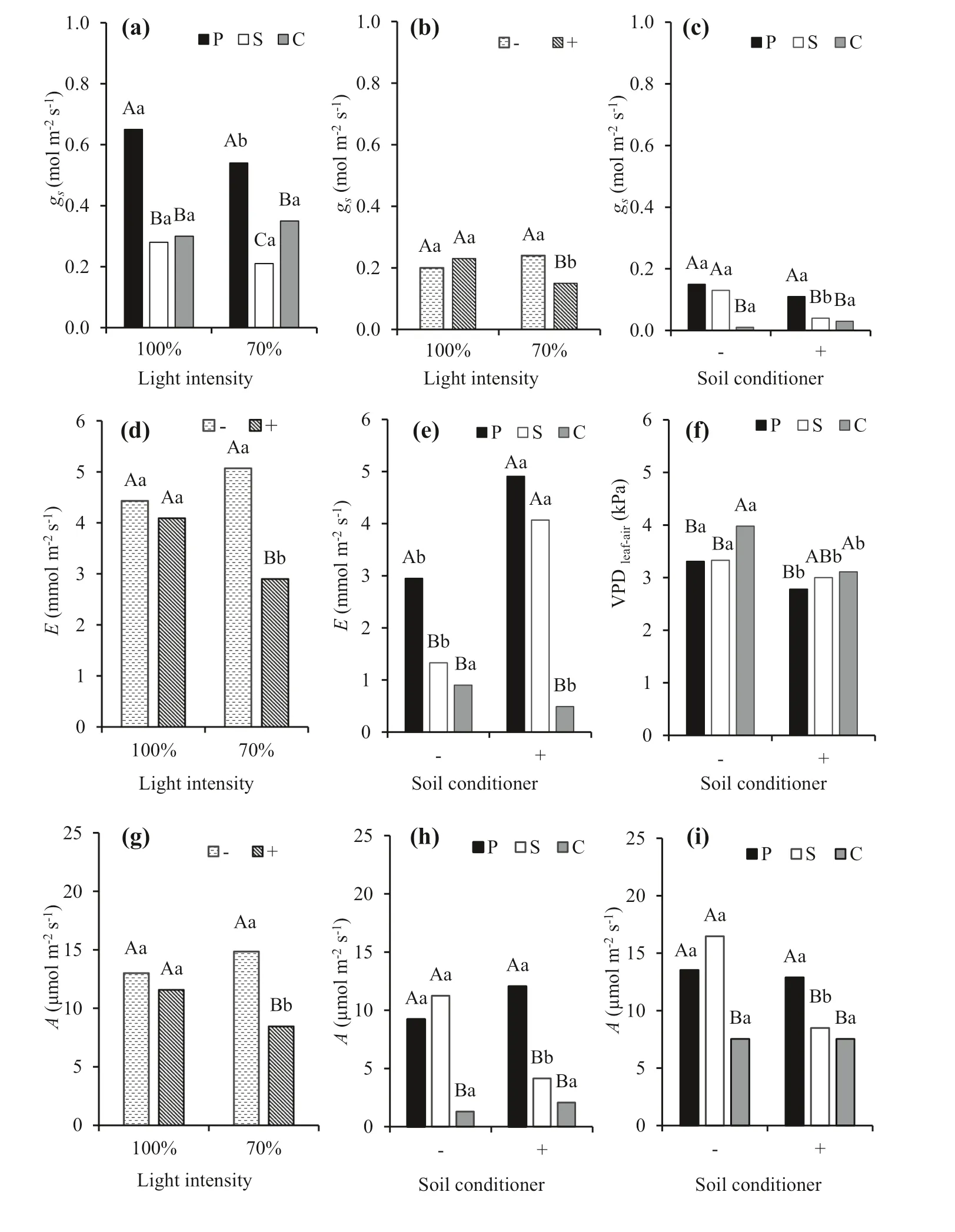
Fig.3 Stomatal conductance (gs),transpiration (E),vapor pressure def icit (VPD),and photosynthetic CO2 assimilation (A) in species in different environments and soil conditions; a =f irst measurement; b,d,and g =second measurement; c,e,f,and h =third measurement; i =fourth measurement;P=pioneer;S=secondary;C=climax;-and+=without and with hydrogel,respectively.Bars with the same uppercase letter and different fillings,or with the same lowercase letter and equal fillings are not significantly different from each other
According to Lestari and Nichols (2017),late successional or climax species tend to acclimatize to different irradiances mainly by adjusting their morphological or biochemical characteristics instead of their photosynthetic capacity,as found by the high SPAD index ofC.rubraunder the 70% luminosity (shaded) environment in the rainy season.However,this is more a response than an adaptation to shading since shaded leaves def initely have higher chlorophyll contents (Souza et al.2017),which result in higher SPAD chlorophyll indexes.
The SPAD index in the last measurement,when the rainy season resumed,was higher in shaded plants (70% light intensity) and without hydrogel.The hydrogel possibly increased the humidity excessively in the shaded environment which hindered chlorophyll biosynthesis,as reported for gabiroba (Campomanesia xanthocarpa(Mart.)) O.Berg.by Santos et al.(2021) who found decreases in SPAD index in seedlings under irrigation when using hydrogel compared seedlings without hydrogel.Dranski et al.(2013) evaluatedJatropha curcasL.in different planting times and usinghydrogel and found that the soil conditioner decreased growth rates in winter planting.
However,the use of hydrogel in full sun favored theFv/Fmand PI during the dry season (third measurement).These results are consistent with those of Santos et al.(2021) who found that hydrogel increased theFv/Fm(maximum quantum efficiency of photosystem II) ofCampomanesia xanthocarpagrown under 25% and 50% water availability.This is possibly due to increases in soil porosity which enhances soil water storage capacity without causing leaching of nutrients (Navroski et al.2015).According to Tomášková et al.(2020),the use of hydrogel during planting is a promising and efficient economical practice to improve survival of species in regions with climate variations since the application of this product does not require the use of machinery or highly technical equipment.
The gas exchange and photosynthetic efficiency responses are possibly more connected to the tolerance to irradiation which is mainly in the dry seasons than to shading (Mendes et al.2017;Santos et al.2019).This was found for the pioneer and secondary species which had higher photosynthetic indexes under 100% light intensity when compared to the climax species.In contrast,the pioneer species showed no changes in photosynthetic indexes due to the environments,which was also found by Nina Junior et al.(2020) who reported that shade could be more difficult to overcome for pioneer plants than the high radiance for late successional species.Therefore,pioneer and secondary species are more adapted to high radiation and hot and dry environments,indicating that they can be grown in regions with these environments.In addition,these species responded better to the use of hydrogel than the climax species,as observed by Santos et al.(2021) who obtained positive results from the use of hydrogel in a secondary species tolerant to drought.
Conclusions
The pioneer and secondary species under 100% luminosity had higher physiological plasticity than the climax species,which makes them better adapted to these conditions.These characteristics are important for their use in reforestation projects of disturbed and degraded environments.Soil conditioning with hydrogel did not affect seedling development,especially for the climax species in the high soil water availability period,but it significantly contributed to the pioneer and secondary species in areas under high radiation and dry periods,improving their photosynthetic efficiency.
FundingThere was no funding.
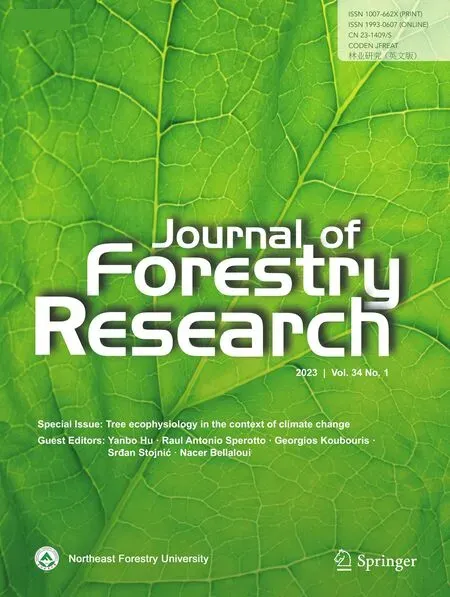 Journal of Forestry Research2023年1期
Journal of Forestry Research2023年1期
- Journal of Forestry Research的其它文章
- Journal of Forestry Research
- Tree ecophysiology in the context of climate change
- Leaf thermal tolerance and sensitivity of temperate tree species are correlated with leaf physiological and functional drought resistance traits
- Modelling the impacts of cover crop management strategies on the water use,carbon exchange and yield of olive orchards
- Near-infrared leaf reflectance modeling of Annona emarginata seedlings for early detection of variations in nitrogen concentration
- A soil quality index for subtropical sandy soils under different Eucalyptus harvest residue managements
